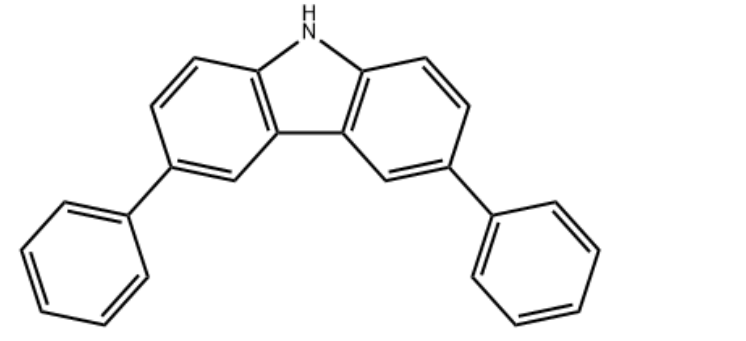
IdentificationPhysical DataSpectraRoute of Synthesis (ROS)Safety and HazardsOther Data
Identification
Product Name3,6-Diphenyl-9H-carbazole IUPAC Name3,6-diphenyl-9H-carbazole Molecular StructureCAS Registry Number 56525-79-2Synonyms3,6-Diphenyl-9H-carbazole56525-79-23,6-diphenylcarbazole9H-Carbazole, 3,6-diphenyl-MFCD002226196654-68-83,6-diphenyl carbazole3,6-Biphenyl-9H-carbazoleOprea1_545753Oprea1_8152423,6-di-phenyl-9h-carbazoleSCHEMBL1496853,6-Diphenylcarbazole, 99%YSZC1788AMY8728DTXSID80985149ACT09862STK927806AKOS002336524OL10012SB66927AC-28755AS-10598SY036866CS-0080917D4433FT-0733900A831073Molecular FormulaC24H17NMolecular Weight319.4InChI InChI=1S/C24H17N/c1-3-7-17(8-4-1)19-11-13-23-21(15-19)22-16-20(12-14-24(22)25-23)18-9-5-2-6-10-18/h1-16,25HInChI KeyPCMKGEAHIZDRFL-UHFFFAOYSA-N Canonical SMILESC1=CC=C(C=C1)C2=CC3=C(C=C2)NC4=C3C=C(C=C4)C5=CC=CC=C5
Patent InformationPatent IDTitlePublication Date CN114656396Organic compound and application thereof, and organic electroluminescent device containing organic compound2022KR2021/75622Novel compound and organic light emitting device comprising the same 2021 KR2021/75621Novel compound and organic light emitting device comprising the same2021KR2021/75620Novel compound and organic light emitting device comprising the same2021 CN112876406Deuterated carbazole compound, preparation method thereof, photoelectric material and medicine2021
Physical Data
AppearanceWhite powder
Melting Point, °C Solvent (Melting Point) 177.1186hexane, ethyl acetate186
Spectra
Description (NMR Spectroscopy)Nucleus (NMR Spectroscopy)Solvents (NMR Spectroscopy)Frequency (NMR Spectroscopy), MHzChemical shifts1Hchloroform-d1400Chemical shifts1Hchloroform-d1400Chemical shifts13Cchloroform-d1Chemical shifts, Spectrum1Hchloroform-d1600Chemical shifts, Spectrum13Cchloroform-d1151
3,6-Diphenyl-9H-carbazole CAS#: 56525-79-2 NMR
Description (IR Spectroscopy)Solvent (IR Spectroscopy)BandsKBr
Description (UV/VIS Spectroscopy)Solvent (UV/VIS Spectroscopy)SpectrumN,N-dimethyl-formamideSpectrumtolueneSpectrumtetrahydrofuran
Route of Synthesis (ROS)
Route of Synthesis (ROS) of 3,6-Diphenyl-9H-carbazole CAS 56525-79-2
ConditionsYieldWith tetrakis(triphenylphosphine) palladium(0); potassium carbonate In 1,4-dioxane; water at 90℃;86%With tetrakis(triphenylphosphine) palladium(0); potassium carbonate In 1,4-dioxane at 90℃; for 24h; Inert atmosphere;86%With tetrakis(triphenylphosphine) palladium(0); potassium carbonate In ethanol; water; toluene at 80℃; for 20h; Inert atmosphere;Experimental ProcedureAdd 3,6-dibromocarbazole (9.75g, 30.00mmol, 1.0 equivalent) to a dry three-necked flask with a magnetic stirring rotor and condenser.Phenylboronic acid (8.78g, 72.00mmol, 2.4 equivalents),Tetrakis(triphenylphosphine)palladium (347mg, 0.3mmol, 10mol%),Potassium carbonate (20.73g, 150.00mmol, 3 equivalents),Then pump nitrogen three times,Add toluene/ethanol/water (30mL/30mL/10mL) under nitrogen protection.The mixture was stirred and reacted in an oil bath at 80°C for 20 hours.TLC monitors until the reaction of the raw materials is complete, and cool to room temperature.A small amount of water was added and extracted twice with dichloromethane.The organic phases were combined, dried over anhydrous sodium sulfate, and filtered.The solvent was distilled off under reduced pressure.The obtained crude product is separated and purified by silica gel chromatography column, eluent: petroleum ether/ethyl acetate=20:1-5:1,The intermediate 3,6-diphenylcarbazole was obtained, 7.95 g of light brown solid, and the yield was 83%.83%
Safety and Hazards
Pictogram(s)SignalWarningGHS Hazard StatementsH302 (33.33%): Harmful if swallowed H315 (100%): Causes skin irritation H317 (33.33%): May cause an allergic skin reaction H319 (100%): Causes serious eye irritation H335 (33.33%): May cause respiratory irritation Precautionary Statement CodesP261, P264, P264+P265, P270, P271, P272, P280, P301+P317, P302+P352, P304+P340, P305+P351+P338, P319, P321, P330, P332+P317, P333+P313, P337+P317, P362+P364, P403+P233, P405, and P501(The corresponding statement to each P-code can be found at the GHS Classification page.)
Other Data
TransportationUnder the room temperature and away from lightHS CodeStorageUnder the room temperature and away from lightShelf Life1 yearMarket Price
DruglikenessLipinski rules componentMolecular Weight319.406logP7.411HBA1HBD1Matching Lipinski Rules3Veber rules componentPolar Surface Area (PSA)15.79Rotatable Bond (RotB)2Matching Veber Rules2
pXParameterValue (qual)Value (quant)UnitTargetEffect8.05pIC50(Virus replication) =8.05antiviral agent8.05pIC50=8.05Topoisomerase dna ii 180kda (Beta) :Wild5.65EC90(Amount Of P24 Protein)>20 µM5.48IC50(protease activity)3.3µM4.63IC5023.45μgantifungal agent4.59IC502.45μg/mlantifungal agent4.45IC503.33μg/mlantifungal agent4stimulation rateActiveHigh voltage-activated calcium channel :Wild3.44IC5034.55μg/mlantifungal agent
Quantitative Results1 of 10Effectinhibitory activityTargetD-amino-acid oxidase :WildSubstance action on targetInhibitorAssay Description Inhibitory concentration of compound against human recombinant D-amino acid oxidase (DAO) expressed in Escherichia coli BL21(DE3)pLysS cells upon incubation in 40 mM sodium pyrophosphate, pH 8.3 for 10 mins at 37 degree C using 10 mM D-Alanine as substrate 2 of 10 Assay DescriptionClog P value of the compound was calculated using Hansch's LogP MeasurementClog P value of the compound 3 of 10Assay DescriptionDissociation constant of the compound was measured by using Hammett's equation MeasurementDissociation constant4 of 10Assay DescriptionHydrogen bond acidity of the compound was determinedMeasurementHydrogen bond acidity5 of 10 TargetFatty-acid amide hydrolase 1:WildSubstance action on targetInhibitorAssay DescriptionInhibitory actvity of the compound against Fatty acid amide hydrolase in 0.1 M sodium phosphate, pH 8.06 of 10Assay DescriptionAcid dissociation constant of compound was determinedMeasurementAcid dissociation constant7 of 10Biological materialCEM-T4 cell lineAssay DescriptionSelectivty index of compound was measured as Cytotoxic concentration against mock infected CEM-T4 cells to that of effective concentration required to acieve HIV induced cytopathogenicityResultsSI50 not calculatedMeasurementSI508 of 10EffectGenotoxicBiological materialHL-60 cell line9 of 10Effectantibiotic agentBiological materialStaphylococcus aureusAssay DescriptionEffect : antistaphylococcal10 of 10Resultseffect on phosphatidylcholine secretion in primary cultures of rat type II pneumocytes
Use Pattern3,6-Diphenyl-9H-carbazole CAS#: 56525-79-2 is an important organic compound with versatile applications. Firstly, it finds extensive use in the field of optoelectronics. 3,6-Diphenyl-9H-carbazole is a fluorescent material and can be employed in the fabrication of organic light-emitting diodes (OLEDs).
https://www.chemwhat.com/36-diphenyl-9h-carbazole-cas-56525-79-2-2/
Comments
Post a Comment